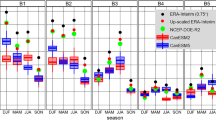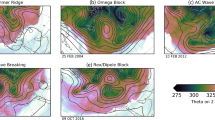Abstract
Daily output from the hindcasts by the NCEP Climate Forecast System version 2 (CFSv2) is analyzed to understand CFSv2’s skill in forecasting wintertime atmospheric blocking in the Northern Hemisphere. Prediction skills of sector blocking, sector-blocking episodes, and blocking onset/decay are assessed with a focus on the Euro-Atlantic sector (20°W–45°E) and the Pacific sector (160°E–135°W). Features of associated circulation and climate patterns are also examined.
The CFSv2 well captures the observed features of longitudinal distribution of blocking activity, but underestimates blocking frequency and intensity and shows a decreasing trend in blocking frequency with increasing forecast lead time. Within 14-day lead time, the Euro-Atlantic sector blocking receives a higher skill than the Pacific sector blocking. Skillful forecast (taking the hit rate of 50% as a criterion) can be obtained up to 9 days in the Euro-Atlantic sector, which is slightly longer than that in the Pacific sector (7 days). The forecast skill of sector-blocking episodes is slightly lower than that of sector blocking in both sectors, and it is slightly higher in the Euro-Atlantic sector than in the Pacific sector. Compared to block onset, the skill for block decay is lower in the Euro-Atlantic sector, slightly higher in the Pacific sector during the early three days but lower after three days in lead time. In both the Euro-Atlantic and the Pacific sectors, a local dipole pattern in 500-hPa geopotential height associated with blocking is well presented in the CFSv2 prediction, but the wave-train like pattern that is far away from the blocking sector can only maintain in the forecast of relative short lead time. The CFSv2 well reproduces the observed characteristics of local temperature and precipitation anomalies associated with blocking.
Similar content being viewed by others
References
Barnes, E. A., J. Slingo, and T. Woollings, 2012: A methodology for the comparison of blocking climatologies across indices, models, and climate scenarios. Climate Dyn., 38, 2467–2481.
Barriopedro, D., R. G. Herrera, and A. R. Lupo, 2006: A climatology of Northern Hemisphere blocking. J. Climate, 19, 1042–1063.
Berggren, R., B. Bolin, and C. G. Rossby, 1949: An aerological study of zonal motion, its perturbations, and break-down. Tellus, 2, 14–37.
Buehler, T., C. C. Raible, and T. F. Stocker, 2011: The relationship of winter season North Atlantic blocking frequencies to extreme cold or dry spells in the ERA-40. Tellus A, 63, 212–222.
Cheung, H. N., W. Zhou, Y. Shao, et al., 2013: Observational climatology and characteristics of wintertime atmospheric blocking over Ural-Siberia. Climate Dyn., 41, 63–79.
Colucci, S. J., and D. P. Baumhefner, 1998: Numerical prediction of the onset of blocking: A case study with forecast ensembles. Mon. Wea. Rev., 126, 773–784.
Croci-Maspoli, M., C. Schwierz, and H. C. Davies, 2007: Atmospheric blocking: Space-time links to the NAO and PNA. Climate Dyn., 29, 713–725.
D’Andrea, F., et al., 1998: Northern Hemisphere atmospheric blocking as simulated by 15 atmospheric general circulation models in the period 1979-1988. Climate Dyn., 14, 385–407.
Diao, Y. N., J. P. Li, and D. H. Luo, 2006: A new blocking index and its application: Blocking action in the Northern Hemisphere. J. Climate, 19, 4819–4839.
Dole, R., et al., 2011: Was there a basis for anticipating the 2010 Russian heat wave? Geophys. Res. Lett., 38, doi: 10.1029/2010GL046582.
Giacomo, M., B. J. Hoskins, T. Woollings, 2013: Winter and summer Northern Hemisphere blocking in CMIP5 models. J. Climate, 26(18), 7044–7059.
He Jinhai and Zhou Xueming, 1995: Numerical study of Ural blocking high’s effect upon Asian summer monsoon circulation and East China flood and drought. Adv. Atmos. Sci., 12(3), 361–370.
Hinton, T. J., B. J. Hoskins, and G. M. Martin, 2009: The influence of tropical sea-surface temperatures and precipitation on North Pacific atmospheric blocking. Climate Dyn., 33, 549–563.
Li Chongyin and Gu Wei, 2010: An analyzing study of the anomalous activity of blocking high over the Ural mountains in January 2008. Chinese J. Atmos. Sci., 34(5), 865–874. (in Chinese)
Li Chao, Zhang Qingyun, Ji Liren, et al., 2012: Interannual variations of the blocking high over the Ural Mountains and its association with the AO/NAO in boreal winter. Acta Meteor. Sinica, 26(2), 163–175.
Masato, G., B. J. Hoskins, and T. J. Woollings, 2011: Wave-breaking characteristics of midlatitude blocking. Quart. J. Roy. Met. Soc., doi: 10.1002/qj.990.
Matsueda, M., R. Mizuta, and S. Kusunoki, 2009: Future change in wintertime atmospheric blocking simulated using a 20-km-mesh atmospheric global circulation model. J. Geophys. Res., 114, doi: 10.1029/2009JD011919.
Pelly, J. L., and B. J. Hoskins, 2003a: How well does the ECMWF ensemble prediction system predict blocking? Quart. J. Roy. Meteor. Soc., 129, 1683–1702.
—, and —, 2003b: A new perspective on blocking. J. Atmos. Sci., 60, 743–755.
Renwick, J., and J. Wallace, 1996: Relationships between North Pacific wintertime blocking, El Niño, and the PNA pattern. Mon. Wea. Rev., 124, 2071–2076.
Rex, D. F., 1950: Blocking action in the middle troposphere and its effects upon regional climate. II: The climatology of blocking action. Tellus, 2, 275–301.
Saha, S., S. Naliga, C. Thiaw, et al., 2006: The NCEP climate forecast system. J. Climate, 19, 3483–3517.
—, et al., 2010: The NCEP Climate Forecast System reanalysis. Bull. Amer. Meteor. Soc., 91, 1015–1057.
—, et al., 2013: The NCEP Climate Forecast System version 2, J. Climate, doi:http://dx.doi.org/10.1175/JCLI-D-12-00823.1.
Scaife, A. A., and J. R. Knight, 2008: Ensemble simulations of the cold European winter of 2005/6. Quart. J. Roy. Meteor. Soc., 134, 1647–1659.
Scaife, A., T. J. Woollings, J. Knight, et al., 2010: Atmospheric blocking and mean biases in climate models. J. Climate, 23, 6143–6152.
Shabbar, A., J. Huang, and K. Higuchi, 2001: The relationship between the wintertime North Atlantic oscillation and blocking episodes in the North Atlantic. Int. J. Climatol., 21, 355–369.
Tibaldi, S., and F. Molteni, 1990: On the operational predictability of blocking. Tellus, 42A, 343–365.
—, E. Tosi, A. Navarra, and L. Pedulli, 1994: Northern and Southern Hemisphere seasonal variability of blocking frequency and predictability. Mon. Wea. Rev., 122, 1971–2003.
—, P. Ruti, E. Tosi, et al., 1995: Operational predictability of winter blocking at ECMWF: An update. Ann. Geophys., 13, 305–317.
Tracton, M. S., 1990: Predictability and its relationship to scale interaction processes in blocking. Mon. Wea. Rev., 118, 1666–1695.
Watson, J. C., and J. C. Stephen, 2002: Evaluation of ensemble predictions of blocking in the NCEP global spectral model. Mon. Wea. Rev., 130, 3008–3021.
Webster, P. J., V. E. Toma, and H. M. Kim, 2011: Were the 2010 Pakistan floods predictable? Geophys. Res. Lett., 38, L04806, doi: 10.1029/2010GL046346.
Wang, W., P. Xie, S. H. Yoo, et al., 2010: An assessment of the surface climate in the NCEP climate forecast system reanalysis. Climate Dyn., 37, 1601–1620.
Wilks, D. S., 1995: Statistical Methods in the Atmospheric Sciences: An Introduction. Academic Press, 467 pp.
Woollings, T., B. Hoskins, M. Blackburn, et al., 2008: A new Rossby wave-breaking interpretation of the North Atlantic oscillation. J. Atmos. Sci., 65, 609–626.
—, A. Charlton-Perez, S. Ineson, et al., 2010: Associations between stratospheric variability and tropospheric blocking. J. Geophys. Res., 115, D06108, doi:10.1029/2009JD012742.
Xue, Y., B. Huang, Z. Z. Hu, et al., 2010: An assessment of oceanic variability in the NCEP climate forecast system reanalysis. Climate Dyn., 37, 2511–2539.
Zhang Qingyun, Xuan Shouli, and Peng Jingbei, 2008: Relationship between Asian circulation in the midhigh latitude and snowfall over South China during La Nina events. Climatic Environ. Res., 13(4), 385–394. (in Chinese)
Author information
Authors and Affiliations
Corresponding author
Additional information
Supported by the National (Key) Basic Research and Development (973) Program of China (2010CB428606 and 2014CB950900), China Meteorological Administration Special Public Welfare Research Fund (GYHY201206017), National Science and Technology Support Program of China (2009BAC51B05), and LASW State Key Laboratory Special Fund (2013LASW-A05).
Rights and permissions
About this article
Cite this article
Jia, X., Yang, S., Song, W. et al. Prediction of wintertime Northern Hemisphere blocking by the NCEP Climate Forecast System. Acta Meteorol Sin 28, 76–90 (2014). https://doi.org/10.1007/s13351-014-3085-8
Received:
Accepted:
Published:
Issue Date:
DOI: https://doi.org/10.1007/s13351-014-3085-8




